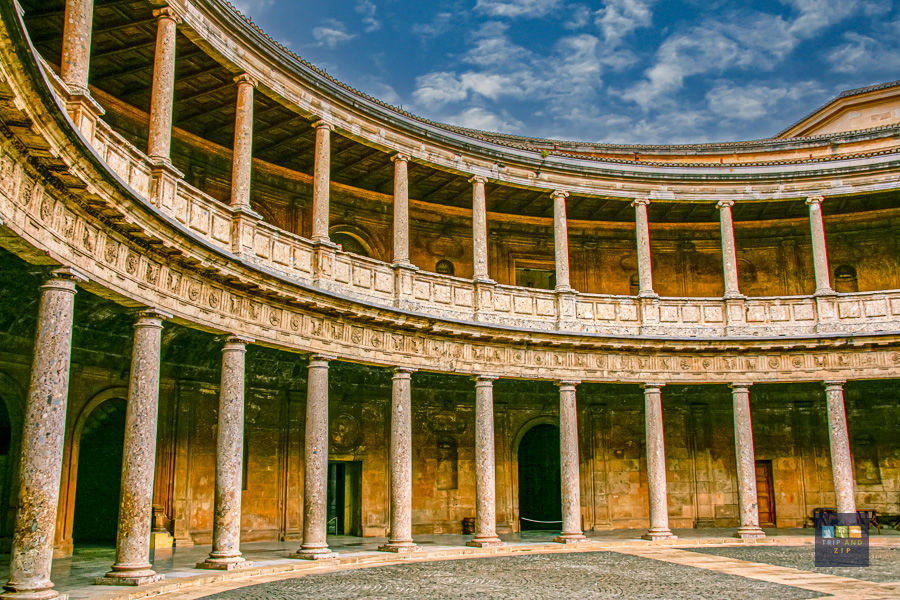The Alhambra: Where Moorish Elegance Meets Timeless Magic (I)
- Trip And Zip

- May 10, 2010
- 3 min read
Part 1 – The Nasrid Palaces and the Renaissance Intrusion
High above Granada city, framed by the snowy peaks of the Sierra Nevada, the Alhambra architectural complex commands presence with quiet grandeur. Among the many places I’ve visited, few have left me as captivated. The Alhambra speaks to everything I admire in the Moorish culture of Andalusia—its elaborate detail, refined symmetry, and the deep connection between intellect and aesthetics.

During the 13th and 14th centuries, under the Nasrid dynasty, this complex became a flourishing court where geometry, poetry, and architecture were treated as one. Scholars and artisans worked side by side, creating a palace that still hums with meaning centuries later.
It's certainly a matter of personal preference, but to me, this combination of refinement, elegance, and beauty is unparalleled.
But this brilliance was also the last light of an era. In 1492, the dramatic fall of Granada ended Muslim rule in Spain, and one legend in particular defines this turning point. As Emir Boabdil surrendered the city to the Christian monarchs, Isabella of Castile and Ferdinand of Aragon, he paused on a hill for one last look at the Alhambra. Overcome with sorrow, he sighed deeply—giving rise to the place’s name, El Suspiro del Moro (The Moor’s Sigh). His grief was met not with comfort, but with a sharp rebuke from his mother, Aixa: “Weep like a woman for what you couldn’t defend like a man.” Her words cut through the centuries, capturing the tragedy of a lost kingdom.


That sense of both beauty and loss permeates the Alhambra. You can begin your walk at the Puerta de la Justicia, a defensive gate adorned with elegant Arabic calligraphy and the Hand of Fatima, a symbol of protection. Even here, where the structure was meant to be strong, the Nasrid aesthetic softens it into something graceful and layered.



Inside the Mexuar, one of the oldest sections, intricate stucco walls and patterned tiles give texture to what was once a council chamber. Light filters in softly, emphasizing the balance between practical governance and artistic thought.
The Palace of Comares opens onto the Patio de los Arrayanes (Court of the Myrtles), where a long reflecting pool catches the arches and colonnades in perfect symmetry. The surrounding myrtle hedges release a light fragrance in spring, adding to the calm.


This was the heart of the sultan’s private residence, culminating in the Salón de los Embajadores (Hall of the Ambassadors), housed in the Torre de Comares. Here, the cedarwood ceiling draws the eye upward—its complex pattern representing the seven heavens, carved with mathematical precision.
The walls of Comares are alive with carved poetry and verses—art and script fused into delicate stucco. Each inscription reflects a world where beauty, faith, and power were written into the very stone.
From there, you move into the Palacio de los Leones, perhaps the most enchanting space in the entire complex. The Patio de los Leones, with its twelve carved marble lions and gently flowing fountain, channels water into four directions, evoking the rivers of paradise. Surrounded by slender columns and poetic inscriptions, this place doesn’t just hint at fantasy—it immerses you in a dream, stepping into the world of 1001 Nights, where imagination and devotion shaped every surface.





In the Nasrid courts and nearby gardens, greenery is seamlessly woven into the architecture. Orange trees, pomegranates, and myrtles thrive beside fountains and tiled paths, blending nature and structure. Soft greens contrast with the warm red tones of the walls, creating a serene visual harmony. More than decoration, these gardens reflect paradise, balance, and renewal—set against the sunlit stone.
And then comes the shift: the Palace of Carlos V. Built after the Christian conquest in a bold Renaissance style, it’s a circular courtyard inside a square exterior. Impressive in symmetry, but it disrupts the fluid beauty of the Nasrid structures. Still, it’s part of the Alhambra’s story—a reminder that empires rise, fall, and leave their mark.

Yet the contrast serves a purpose. It reminds you how civilizations imprint their identity in stone. The Nasrid palaces remain a testament to a culture that prized intellect, spirituality, and design—woven seamlessly into space. A place where mathematics meets poetry, where architecture becomes language, and where every carved word and shadowed arch echoes the grace of a lost world.





















Comments